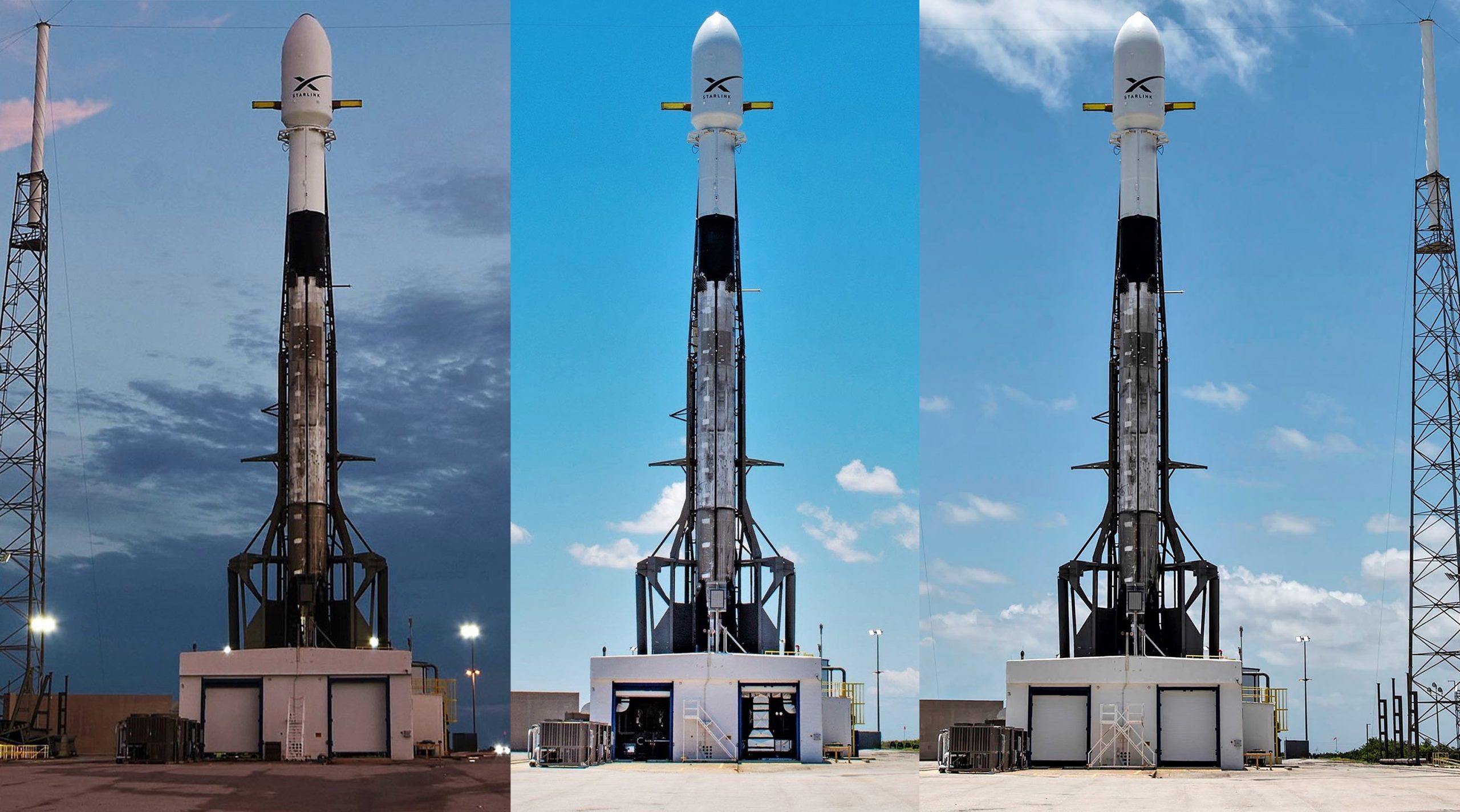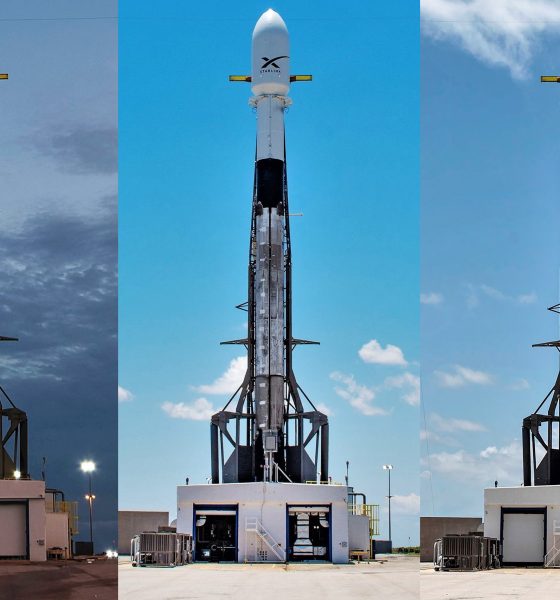

News
SpaceX ready for 60-satellite Starlink launch debut: third time’s the charm?
SpaceX is approximately two hours away from its third Starlink v0.9 launch attempt, an ambitious batch of 60 satellites that will also be the company’s heaviest payload ever.
As hinted at by the name “Starlink v0.9”, these sixty satellites are not quite the final design. More a beta test at an unprecedented scale, several critical new technologies and strategies will be put to the test on this launch, ranging from a seriously unorthodox satellite deployment method to the near-final krypton-fueled electric thrusters. Same as SpaceX’s May 15th and 16th launch attempts, Starlink v0.9’s third try has a 90-minute window that opens at 10:30 pm EDT (02:30 UTC), this time on Thursday, May 23rd.
Third time’s the charm ?
May 23rd’s Starlink v0.9 launch attempt will be the mission’s third, preceded by May 15th – scrubbed by high-altitude wind shear – and May 16th, cancelled before fueling began in order to troubleshoot and update the software aboard the 60 Starlink satellites. After a week of concerted effort from SpaceX technicians and software developers, those issues have been more or less dealt with and the first batch of Starlink satellites are once again ready for orbit.

According to SpaceX, the massive payload of 60 flat-packed Starlink satellites weighs approximately 18.5 tons (16,800-18,500 kg, unclear if short or metric tons). Either way, it will easily break SpaceX’s previous record – likely Crew Dragon’s DM-1 debut – and become the heaviest payload the company has ever attempted to launch. Despite the sheer size and mass of the payload, Falcon 9 booster B1049 – launching for the third time – will still be able to land aboard drone ship Of Course I Still Love You (OCISLY) some eight minutes after launch.
If the recovery goes well, B1049 will become the third SpaceX booster to successfully complete three orbital-class launches and landings, paving the way for a series of fourth flights (and beyond) later this year.
Cubesats, meet Flatsats
Aside from the mission’s impressive rocket performance requirements, Starlink v0.9 will also serve as a huge beta test of a dozen or more new technologies. The most visible of those has to be each satellite’s truly unique flat, rectangular form factor, as well as SpaceX’s use of flat-packing in place of a dedicated structure for holding and dispensing the satellites. It’s unclear if there is some additional reinforcement or if the satellites themselves provide all of the stack’s strength. If the latter is true, the satellites at the bottom must survive massive forces – ranging from ~7000 kg at rest to 35,000+ kg at the end of Falcon 9’s second stage burn.
Aside from their exotic structure, each Starlink satellite also carries a single-panel ~3 kW solar array using one of two experimental deployment mechanisms. Each satellite’s main propulsion comes from an unknown number of Hall Effect thrusters (i.e. electric/ion thrusters) fueled by krypton instead of the usual xenon. SpaceX’s internally-developed krypton thrusters are the only known examples to have been tested in orbit.
Aside from thrusters, SpaceX CEO Elon Musk also believes that the company’s space-based phased array antennas – also developed in-house – are more advanced than any operational competitor on Earth. Musk also revealed that SpaceX would attempt to use a bizarre and largely untested method of satellite deployment, spinning Falcon 9’s upper stage and releasing the satellites with inertia instead of traditional springs or pushrods.
Regardless of whether everything works as planned, the launch is going to be a spectacular one and the webcast may even include views of the bizarre satellite deployment. Catch SpaceX’s live coverage of the mission – likely to include new details about the Starlink constellation – at the link below. Coverage will begin ~15 minutes prior to liftoff.
Check out Teslarati’s Marketplace! We offer Tesla accessories, including for the Tesla Cybertruck and Tesla Model 3.

Elon Musk
Elon Musk and Tesla AI Director share insights after empty driver seat Robotaxi rides
The executives’ unoccupied tests hint at the rapid progress of Tesla’s unsupervised Robotaxi efforts.

Tesla CEO Elon Musk and AI Director Ashok Elluswamy celebrated Christmas Eve by sharing personal experiences with Robotaxi vehicles that had no safety monitor or occupant in the driver’s seat. Musk described the system’s “perfect driving” around Austin, while Elluswamy posted video from the back seat, calling it “an amazing experience.”
The executives’ unoccupied tests hint at the rapid progress of Tesla’s unsupervised Robotaxi efforts.
Elon and Ashok’s firsthand Robotaxi insights
Prior to Musk and the Tesla AI Director’s posts, sightings of unmanned Teslas navigating public roads were widely shared on social media. One such vehicle was spotted in Austin, Texas, which Elon Musk acknowleged by stating that “Testing is underway with no occupants in the car.”
Based on his Christmas Eve post, Musk seemed to have tested an unmanned Tesla himself. “A Tesla with no safety monitor in the car and me sitting in the passenger seat took me all around Austin on Sunday with perfect driving,” Musk wrote in his post.
Elluswamy responded with a 2-minute video showing himself in the rear of an unmanned Tesla. The video featured the vehicle’s empty front seats, as well as its smooth handling through real-world traffic. He captioned his video with the words, “It’s an amazing experience!”
Towards Unsupervised operations
During an xAI Hackathon earlier this month, Elon Musk mentioned that Tesla owed be removing Safety Monitors from its Robotaxis in Austin in just three weeks. “Unsupervised is pretty much solved at this point. So there will be Tesla Robotaxis operating in Austin with no one in them. Not even anyone in the passenger seat in about three weeks,” he said. Musk echoed similar estimates at the 2025 Annual Shareholder Meeting and the Q3 2025 earnings call.
Considering the insights that were posted Musk and Elluswamy, it does appear that Tesla is working hard towards operating its Robotaxis with no safety monitors. This is quite impressive considering that the service was launched just earlier this year.
Elon Musk
Starlink passes 9 million active customers just weeks after hitting 8 million
The milestone highlights the accelerating growth of Starlink, which has now been adding over 20,000 new users per day.

SpaceX’s Starlink satellite internet service has continued its rapid global expansion, surpassing 9 million active customers just weeks after crossing the 8 million mark.
The milestone highlights the accelerating growth of Starlink, which has now been adding over 20,000 new users per day.
9 million customers
In a post on X, SpaceX stated that Starlink now serves over 9 million active users across 155 countries, territories, and markets. The company reached 8 million customers in early November, meaning it added roughly 1 million subscribers in under seven weeks, or about 21,275 new users on average per day.
“Starlink is connecting more than 9M active customers with high-speed internet across 155 countries, territories, and many other markets,” Starlink wrote in a post on its official X account. SpaceX President Gwynne Shotwell also celebrated the milestone on X. “A huge thank you to all of our customers and congrats to the Starlink team for such an incredible product,” she wrote.
That growth rate reflects both rising demand for broadband in underserved regions and Starlink’s expanding satellite constellation, which now includes more than 9,000 low-Earth-orbit satellites designed to deliver high-speed, low-latency internet worldwide.
Starlink’s momentum
Starlink’s momentum has been building up. SpaceX reported 4.6 million Starlink customers in December 2024, followed by 7 million by August 2025, and 8 million customers in November. Independent data also suggests Starlink usage is rising sharply, with Cloudflare reporting that global web traffic from Starlink users more than doubled in 2025, as noted in an Insider report.
Starlink’s momentum is increasingly tied to SpaceX’s broader financial outlook. Elon Musk has said the satellite network is “by far” the company’s largest revenue driver, and reports suggest SpaceX may be positioning itself for an initial public offering as soon as next year, with valuations estimated as high as $1.5 trillion. Musk has also suggested in the past that Starlink could have its own IPO in the future.
News
NVIDIA Director of Robotics: Tesla FSD v14 is the first AI to pass the “Physical Turing Test”
After testing FSD v14, Fan stated that his experience with FSD felt magical at first, but it soon started to feel like a routine.

NVIDIA Director of Robotics Jim Fan has praised Tesla’s Full Self-Driving (Supervised) v14 as the first AI to pass what he described as a “Physical Turing Test.”
After testing FSD v14, Fan stated that his experience with FSD felt magical at first, but it soon started to feel like a routine. And just like smartphones today, removing it now would “actively hurt.”
Jim Fan’s hands-on FSD v14 impressions
Fan, a leading researcher in embodied AI who is currently solving Physical AI at NVIDIA and spearheading the company’s Project GR00T initiative, noted that he actually was late to the Tesla game. He was, however, one of the first to try out FSD v14.
“I was very late to own a Tesla but among the earliest to try out FSD v14. It’s perhaps the first time I experience an AI that passes the Physical Turing Test: after a long day at work, you press a button, lay back, and couldn’t tell if a neural net or a human drove you home,” Fan wrote in a post on X.
Fan added: “Despite knowing exactly how robot learning works, I still find it magical watching the steering wheel turn by itself. First it feels surreal, next it becomes routine. Then, like the smartphone, taking it away actively hurts. This is how humanity gets rewired and glued to god-like technologies.”
The Physical Turing Test
The original Turing Test was conceived by Alan Turing in 1950, and it was aimed at determining if a machine could exhibit behavior that is equivalent to or indistinguishable from a human. By focusing on text-based conversations, the original Turing Test set a high bar for natural language processing and machine learning.
This test has been passed by today’s large language models. However, the capability to converse in a humanlike manner is a completely different challenge from performing real-world problem-solving or physical interactions. Thus, Fan introduced the Physical Turing Test, which challenges AI systems to demonstrate intelligence through physical actions.
Based on Fan’s comments, Tesla has demonstrated these intelligent physical actions with FSD v14. Elon Musk agreed with the NVIDIA executive, stating in a post on X that with FSD v14, “you can sense the sentience maturing.” Musk also praised Tesla AI, calling it the best “real-world AI” today.








